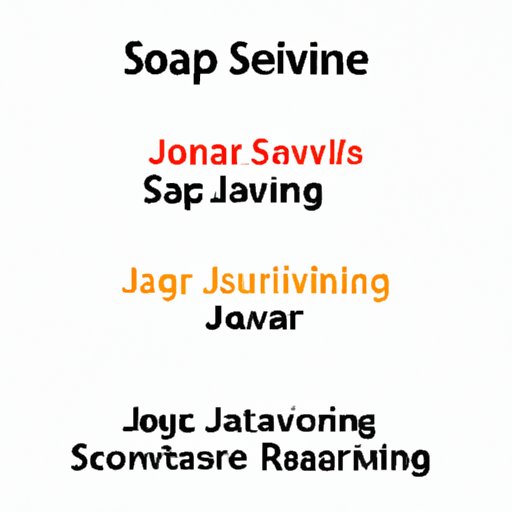Introduction
Sorting a list is an important task in any programming language, including Java. It helps in organizing the data and performing efficient search operations. This article aims to provide an overview of various methods and algorithms that can be used to sort a list in Java. This article is written for Java programmers who want to enhance their knowledge of sorting a list.
Using the Collections.sort() method
The Collections.sort() method is a built-in method in Java that can be used to sort a list of objects. The method takes a list as input and sorts it in ascending order. The elements of the list must implement the Comparable interface. Here is an example of how to use the method:
List<String> names = new ArrayList<>();
names.add("John");
names.add("Alice");
names.add("Bob");
Collections.sort(names);
System.out.println(names);
This will output the following in the console: [Alice, Bob, John]
Implementing the Comparable interface
If the elements of the list do not implement the Comparable interface, the Collections.sort() method will throw a ClassCastException. The Comparable interface has a compareTo() method that returns an integer value. If the value is 0, then the two objects are equal. If it is negative, then the first object is smaller than the second object. If it is positive, then the first object is greater than the second object. Here is an example of how to implement the Comparable interface:
public class Person implements Comparable<Person> {
private String name;
private int age;
public Person(String name, int age){
this.name = name;
this.age = age;
}
public int compareTo(Person other){
return this.age - other.age;
}
}
This implementation will sort a list of persons based on their age.
Implementing the Comparator interface
The Comparator interface can be used to sort objects based on a specific criterion other than their natural ordering. The interface has a compare() method that takes two objects as input and returns an integer value. If the value is 0, then the two objects are equal. If it is negative, then the first object is smaller than the second object. If it is positive, then the first object is greater than the second object. Here is an example of how to use the Comparator interface:
public class PersonComparator implements Comparator<Person> {
public int compare(Person p1, Person p2){
return p1.getName().compareTo(p2.getName());
}
}
This implementation will sort a list of persons based on their name.
Using the Arrays.sort() method
The Arrays.sort() method is used to sort an array of objects. We can convert a list to an array using the toArray() method and then sort the array using this method. Here is an example of how to use the method:
List<String> names = new ArrayList<>();
names.add("John");
names.add("Alice");
names.add("Bob");
String[] namesArray = names.toArray(new String[names.size()]);
Arrays.sort(namesArray);
List<String> sortedNames = Arrays.asList(namesArray);
System.out.println(sortedNames);
This will output the following in the console: [Alice, Bob, John]
Bubble sort
Bubble sort is a simple sorting algorithm that repeatedly swaps adjacent elements if they are in the wrong order. It has a worst-case and average-case time complexity of O(n^2). Here is an implementation of bubble sort in Java:
public void bubbleSort(int[] array){
int n = array.length;
for(int i=0; i<n-1; i++){
for(int j=0; j<n-i-1; j++){
if(array[j] > array[j+1]){
int temp = array[j];
array[j] = array[j+1];
array[j+1] = temp;
}
}
}
Merge sort
Merge sort is a divide and conquer algorithm that sorts a list by dividing it into two halves, sorting each half separately, and then merging the two sorted halves. It has a worst-case, average-case, and best-case time complexity of O(nlogn). Here is an implementation of merge sort in Java:
public static void mergeSort(int[] array){
if(array.length <= 1){
return;
}
int mid = array.length/2;
int[] left = new int[mid];
int[] right = new int[array.length-mid];
for(int i=0; i<mid; i++){
left[i] = array[i];
}
for(int i=mid; i<array.length; i++){
right[i-mid] = array[i];
}
mergeSort(left);
mergeSort(right);
merge(left, right, array);
}
Quick sort
Quick sort is a divide and conquer algorithm that selects a pivot element and partitions the other elements into two sub-lists, according to whether they are less than or greater than the pivot. It has a worst-case time complexity of O(n^2) but a best- and average-case time complexity of O(nlogn). Here is an implementation of quick sort in Java:
public static void quickSort(int[] array, int low, int high){
if(low < high){
int pi = partition(array, low, high);
quickSort(array, low, pi-1);
quickSort(array, pi+1, high);
}
}
Conclusion
Sorting a list is an important operation in Java, and several methods and algorithms can be used to accomplish this task. In this article, we have covered several sorting methods and algorithms, including the Collections.sort() method, Comparable interface, Comparator interface, Arrays.sort() method, bubble sort, merge sort, and quick sort. By using these methods and algorithms effectively, programmers can make their code efficient and organized.
